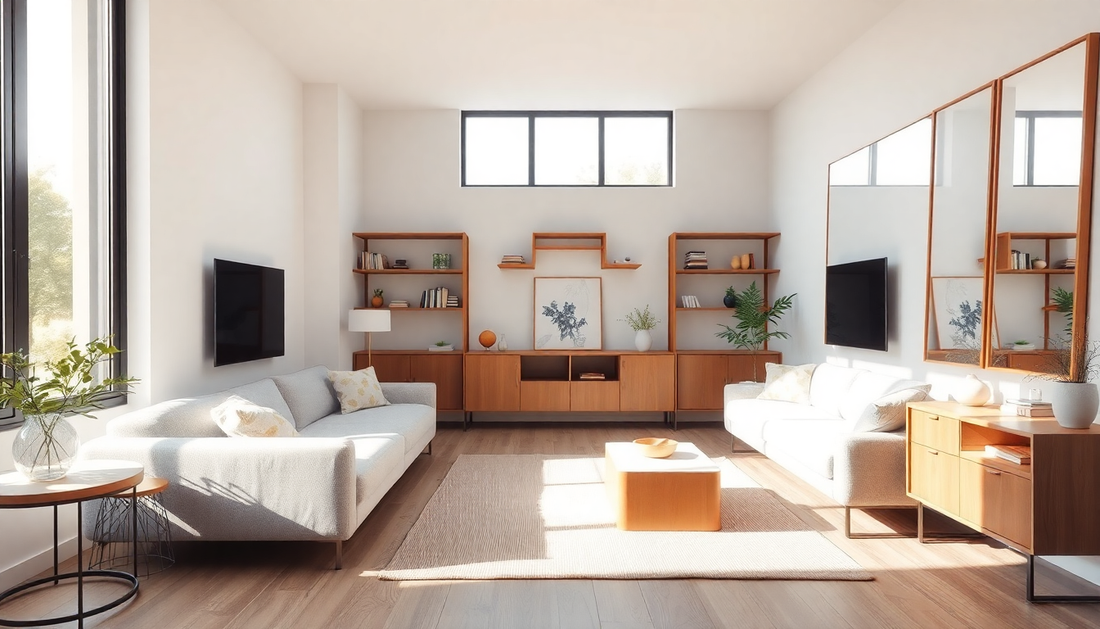
Small Home, Big Feel: Interior Tips to Maximize Your Space
Living in a small home can present unique challenges when it comes to interior design and organization. However, with the right strategies, you can create a space that feels open, airy, and inviting, regardless of its square footage. In this blog post, we'll explore a variety of interior tips and tricks to help you make the most of your small living space.
Embrace Light and Bright Colors
One of the most effective ways to make a small room feel larger is to incorporate light colors and maximize natural light. Opt for light-colored walls, floors, and furnishings, as these will reflect more light and create a sense of openness. Avoid dark, heavy colors, as they can make a space feel closed in and claustrophobic.
Additionally, ensure that you're taking advantage of any natural light sources in the room. Hang sheer curtains or blinds that can be easily opened to allow sunlight to flood the space. You can also strategically place mirrors to reflect and amplify the natural light, further enhancing the sense of spaciousness.
Utilize Multifunctional Furniture
When living in a small home, it's essential to make the most of every square inch. Invest in furniture that serves multiple purposes, such as ottomans with built-in storage or coffee tables with hidden compartments. This will help you reduce clutter and free up valuable floor space.
Another great option is to choose furniture with slim, streamlined silhouettes. Opt for pieces that don't take up too much visual space, like a slender sofa or a compact dining table. By selecting furniture that doesn't overwhelm the room, you can create a more open and airy feel.
Maximize Vertical Space
In a small home, it's important to think vertically as well as horizontally. Utilize wall space by installing shelves, bookcases, or wall-mounted storage units. This will allow you to keep items off the floor and free up valuable surface area.
You can also take advantage of the space above doorways and windows by adding floating shelves or hanging plants. These vertical elements will draw the eye upward, creating the illusion of a taller room.
Embrace Minimalism
When it comes to small spaces, less is often more. Embrace a minimalist approach to your decor, focusing on only the essentials and avoiding clutter. Limit the number of decorative items and opt for clean, streamlined pieces that don't overwhelm the room.
Consider investing in multi-purpose storage solutions, such as ottomans or benches with hidden compartments, to keep your space organized and free of visual distractions. Additionally, be mindful of the scale of your furnishings, choosing pieces that are proportionate to the size of the room.
Utilize Reflective Surfaces
Mirrors are a small-space designer's best friend. Strategically placed mirrors can create the illusion of depth and make a room feel larger than it is. Hang mirrors across from windows to reflect natural light, or place them opposite each other to create the effect of a never-ending space.
You can also incorporate other reflective surfaces, such as glass or metallic accents, to help bounce light around the room and create a sense of openness.
Arrange Furniture Thoughtfully
The way you arrange your furniture can have a significant impact on the perceived size of a room. Avoid pushing all your furniture against the walls, as this can make the space feel closed in. Instead, try floating your furniture in the center of the room, leaving a bit of space around the edges.
Additionally, consider using smaller-scale furniture pieces that don't overwhelm the space. Opt for a loveseat instead of a full-size sofa, or choose a compact dining table with slender chairs.
Incorporate Multifunctional Lighting
Lighting is another crucial element in making a small space feel larger. Utilize a combination of ambient, task, and accent lighting to create depth and visual interest. Install dimmers to allow you to adjust the lighting levels as needed, creating a cozy or airy atmosphere.
Consider using floor lamps or wall-mounted sconces to free up surface area and create the illusion of a taller room. You can also incorporate reflective light fixtures, such as mirrored or metallic lamps, to help bounce light around the space.
Conclusion
Living in a small home doesn't have to mean sacrificing style or comfort. By implementing these interior design tips and tricks, you can create a space that feels open, airy, and inviting, regardless of its square footage. Remember to focus on maximizing natural light, utilizing multifunctional furniture, and embracing a minimalist approach to your decor. With a little creativity and strategic planning, you can transform your small home into a cozy, functional, and visually appealing oasis.
